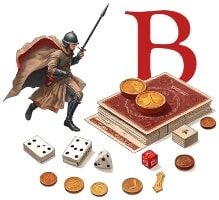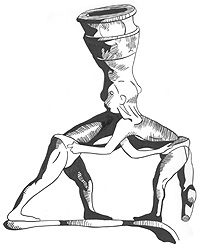“The authority of the prince must be defended by a military force, that force can only be maintained by taxes, all taxes must at last fall upon agriculture, and agriculture can never flourish except under the protection of justice and moderation.”
-Artexerxes
…
Noting that the enemies of Rome had been in its very bossom for some 300 years now at the end of Chapter 7, and that any man positioned to commit the most ruthless crime might for a time usurp the scepter of the world, Gibbon closes with the observation that the barbarians from outside the empire, two of whom had recently become emperors, had taken note of Rome’s “fled” vitality, of its decline. Like a great fat beast dying of cancer, Rome is now being stalked by ever bolder predators.
In Chapter 8, Gibbon devotes the entire effort to the rebirth of the Persian Empire and religion. This takes us into another Arуan sphere, to include a brief sketch of the Parthians who famously wiped out Crassus and his legions 300 years earlier. These cousins of the Scythians and Sarmatians had been the constant enemies of the Empire of Cyrus in antiquity and were finally expelled after they groaned under a foreign yoke for 500 years.
Mithraic faith and the orthodoxy of Zoroaster had fractured and been corrupted over the long centuries of oppression. The man who would deliberately summon the magi from all corners of the reconstituted empire was the bastard son of a tanner’s wife and a soldier. From that soldier the dynasty would by named Sassanid. One of the most militant hereditary monarchies was born with a common theme.
The Parthian King Ataban was jealous of his most competent Persian vassal and neglected the Roman habit of murdering the most able underling and instead cast him into disfavor, from whence he would rise in revolt and after three battles defeat and slay his former master. Then, in 14 years of rule, he created a nation with a civic code and restored state religion, personally leading its armies.
Artexerxes was politically as much of “a unit” as the most complete athlete is in a given sport. However, the lack of resources of his realm, compared to those of Rome would make the hundreds of years of wars waged to return the ancient Persian possessions to his dynasty, so ruinous, that Persia would be swept away by the Arabs so completely, that Muslim tyranny over Persia is referenced often in Gibbon’s reconstruction of pre-Islamic Persia.
Artexerxes, when he summoned the magi, was mobbed by 80,000 priests. These were winnowed to 40,000, then 4,000 then 40 and finally to the seven most respected magi. To settle on a codified orthodoxy, the most brilliant magi was given three cups of drugged wine by his fellows. He fell into a long and profound sleep. When he awakened he recounted conversations with The Creator and answered all doctrinal questions. In this, Artexerxes predicted very closely the calling of the Council of Nicea in 371 by Constantine. The similarity to these two events and of George Washington holding Congress hostage in Philadelphia until they finally agreed on the Constitution is uncanny.
Artexerxis was the Hammurabi of late antiquity, who held more in common with the socialist tyrants of the 20th century then with most ancient rulers. Augustus and Constantine approached empire in a like way as social architects. The Sassanid Dynasty was perhaps the most orthodox faith-based political system mankind has developed.
Gibbon’s overview of this deliberately constructed state is vivid and pleasing and conducted at the point in the Roman decline when two emperors have now perished by treachery while dealing with the newly risen Persian menace out of the east.
Zoroaster is, being a philosopher, a prophet that Gibbon has a critical tolerance for, complimenting that faith in a discussion of sacred acts:
“...seldom to be found among the grovelling and visionary schemes of superstition…” that acts such as fasting amount to “...a criminal rejection of the best gifts of providence...”
On the other hand Gibbon notes ritual absurdities associated with clipping fingernails and such and returns to the core of this faith as a religion as being wedded to agriculture and the ideal of the Garden as it’s rival Christianity.
“He who sows the ground with care and diligence acquires a greater stock of religious merit than he could gain by the repetition of ten thousand prayers.”
Gibbon notes that Zoroasterism in his time, had been, so far as it had survived, adjusted under Muslim pressure. A chilling rendition of mass slaughter of heretics echoed in the Inquisition and Reformation ultimately brings the historian’s deserved criticism and again reminds the reader that ideology and religion share the same social spectrum.
Gibbon writes happily on the habit of the Persian kings sharing a dinner table with common husbandmen and hearing their petitions once each spring. Overall, while sharing violence as a trade with the Roman Emperor, the Persian head of state shines as a kind of proto-chivalric hero, a crusader king, riding strictly a straight, steep and narrow path. By comparison, the far richer Rome produced a register degenerate rulers.
We should finish with one more glimpse of the hero king that took up the torch of vengeance against Rome, rapist of the world, that Hannibal had once carried:
“The Great King commanded the Romans to depart from all of the provinces of his ancestors...and to content themselves with the undisturbed possession of Europe.”
After the litany of weak, craven, cruel or scheming Roman Emperors over the previous 7 chapters and as many decades, it is a narrative relief to hear of a King finally taking the stage again.
The lies and propaganda of the Romans after getting tooled up by the Persians in 2 of 3 battles, claiming victory, departs from the ancient Roman habit of reporting honestly by exaggerating the enemy force size. Gibbon extends his research on how many Elephants the Persians might have fielded to an examination of the army of Siam of his own day, who used 18 elephants per a brigade, roughly 1 per every hundred men.











